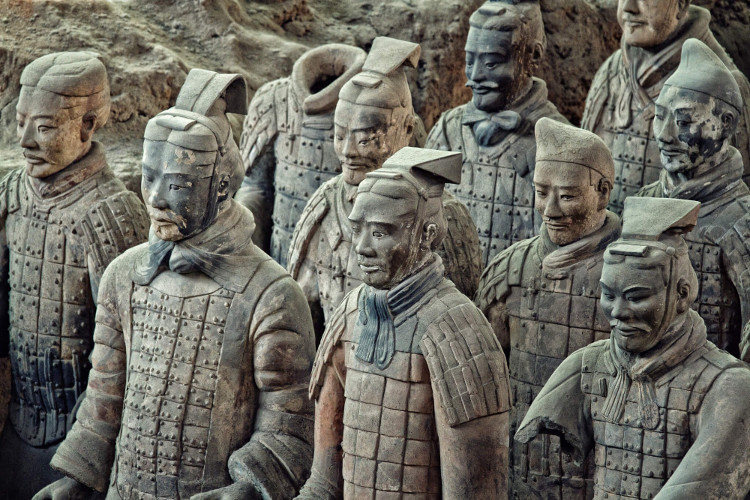The mystery of the weapons inside the tomb of Qin Shihuang - thousand years is still sharp
The swords, battle axes, crossbows . after thousands of years are still very sharp, despite the extremely humid surroundings. What happened in Thuy Hoang Tomb?
History shows that Qin Shihuang prepared his death very carefully. He created a giant tomb like a palace, cast one of 6,000 statues of soldiers and horses in the real size of the gate, to protect the Emperor's eternal sleep.

Terracotta army "town support" Tomb of Thuy Thuy Hoang.
Things are not entirely planned. Only a short time after his death, the successor attacked straight into the tomb, burning everything. The terracotta army collapsed, and the remnants were buried under ash. The tomb sinks into oblivion, until a farmer accidentally unearths a terracotta warrior's debris in 1974. And since then, mankind has an additional monument worthy of being ranked in every period. mandarin
For historians, his tomb is a treasure of knowledge, which contains mysterious and curious topics. One of them is the number of bronze weapons - including more than 40,000 items scattered throughout the ruins.
The mystery lies in the fact that, through more than 2,200 years under the wet ground, these weapons are still extremely sharp, even somewhat glossy - something that was truly utopian, but it happened.
The mysterious, thousand-year-old mystery of the terracotta army in
Weapons scattered in the Emperor's tomb include sword swords, battle axes, crossbow bows with metal caps . In the Qin Dynasty, copper was the main metal, so all these weapons were made of copper.

Bronze weapons over time will have a distinctive green color
Copper items over time must be oxidized into green. But these weapons are not really, they are more metallic gray, especially in the sharp tongue.
Why so? This mystery has made a lot of experts headaches. But in the end, we also got answers from the analysis provided by the Chinese Institute of Metal Research and the National Archaeological Academy.
Accordingly, these weapons have been coated with a layer of chromium oxide 10 - 15 microns thick (1 micron = 1/1000 mm), accounting for about 2% of the metal mass. This oxide layer is very stable, and itself protects the metal inside from the attack of time.
But what's the problem with this oxide layer? According to modern history, the chrome coating method to prevent wear and tear of metals has emerged in Germany since 1937. Americans adopt this method even longer - in 1950s. Yet, Chinese people have applied it from 2,200 years ago.

But the sword in the Qin Shihuang tomb is gray due to the chrome coating.
However, many people disagree with this solution, because in addition to the sharp tongue, other areas on the sword are still rusted, corrosive quite seriously. If it was a natural process, why didn't it spread more than the entire sword?
Moreover, according to some opinions of historians, it seems that the level of Chinese forging skills was really admirable. For example, Viet Vuong's fishing rod from the previous Spring and Autumn period was also made of bronze, but in a sharp and shiny state despite being more than 2,000 years old.

Viet Vuong Cau Tien's sword, currently on display in the Hubei museum - China.
Tests show that the body of the sword is mostly made of copper, but the edge has a high tin ratio, and the composition is mixed with sulfur to increase the shine. This proves that mixing different metals to increase the sharpness and the ability to preserve the sword is a technique that has existed in China for a long time.
However, that still only stops at the hypothesis. Really, the Qin people possessed advanced metal forging techniques, or was it all just coincidence? It is still a mystery without a solution.
- China excavated the tomb of Qin Shihuang's grandmother
- The mystery of the tomb Qin Shihuang
- Discover treasure in the tomb of Qin Shihuang
- The secret still covers the tomb of Qin Shihuang
- The sophisticated weapon of the terracotta army in the tomb of Qin Shihuang
- Found the palace in the tomb of Qin Shihuang
- The deadly weapon of the terracotta army, the tomb of Qin Shi Huang
- Discovering foreign soldiers in the tomb of Qin Shihuang
- Detecting the precious weapon of Qin Shihuang
- Tomb of Qin Shihuang - China
- The Greeks built an army to guard the tomb of Qin Shihuang
- Mysterious 'mystical' burial place 4,000 years old in England
 Discovered an ancient centipede fossil 99 million years old
Discovered an ancient centipede fossil 99 million years old Discovered bat-like dinosaurs in China
Discovered bat-like dinosaurs in China Discovered a 200-year-old bronze cannon of the coast
Discovered a 200-year-old bronze cannon of the coast Discover 305 million-year-old spider fossils
Discover 305 million-year-old spider fossils Archaeologist unearths strange 'dragon' in field, expert: 'Report to police as soon as possible'
Archaeologist unearths strange 'dragon' in field, expert: 'Report to police as soon as possible'  'Never Known' Species Found in Qin Shi Huang's Grandmother's Tomb
'Never Known' Species Found in Qin Shi Huang's Grandmother's Tomb  The ancient tombs were all sealed from the inside, how did the last worker escape?
The ancient tombs were all sealed from the inside, how did the last worker escape?  Egyptologist suffers mysterious illness while opening ancient tomb
Egyptologist suffers mysterious illness while opening ancient tomb  Digging a 3,500m high 'water tomb', China found a huge treasure mine, the secret of the Silk Road is revealed!
Digging a 3,500m high 'water tomb', China found a huge treasure mine, the secret of the Silk Road is revealed!  The world's oldest earthquake-proof tomb
The world's oldest earthquake-proof tomb 